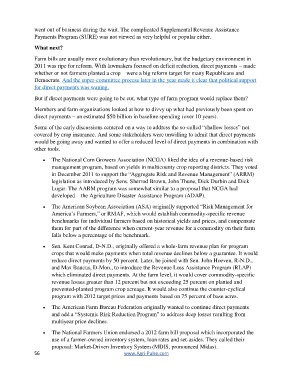Page 58 - Farm Bill Series_The 7 Things You Should Know
P. 58
went out of business during the wait. The complicated Supplemental Revenue Assistance
Payments Program (SURE) was not viewed as very helpful or popular either.
What next?
Farm bills are usually more evolutionary than revolutionary, but the budgetary environment in
2011 was ripe for reform. With lawmakers focused on deficit reduction, direct payments – made
whether or not farmers planted a crop – were a big reform target for many Republicans and
Democrats. And the super-committee process later in the year made it clear that political support
for direct payments was waning.
But if direct payments were going to be cut, what type of farm program would replace them?
Members and farm organizations looked at how to divvy up what had previously been spent on
direct payments – an estimated $50 billion in baseline spending (over 10 years).
Some of the early discussions centered on a way to address the so-called “shallow losses” not
covered by crop insurance. And some stakeholders were unwilling to admit that direct payments
would be going away and wanted to offer a reduced level of direct payments in combination with
other tools.
• The National Corn Growers Association (NCGA) liked the idea of a revenue-based risk
management program, based on yields in multicounty crop reporting districts. They voted
in December 2011 to support the “Aggregate Risk and Revenue Management” (ARRM)
legislation as introduced by Sens. Sherrod Brown, John Thune, Dick Durbin and Dick
Lugar. The AARM program was somewhat similar to a proposal that NCGA had
developed – the Agriculture Disaster Assistance Program (ADAP).
• The American Soybean Association (ASA) originally supported “Risk Management for
America’s Farmers,” or RMAF, which would establish commodity-specific revenue
benchmarks for individual farmers based on historical yields and prices, and compensate
them for part of the difference when current-year revenue for a commodity on their farm
falls below a percentage of the benchmark.
• Sen. Kent Conrad, D-N.D., originally offered a whole-farm revenue plan for program
crops that would make payments when total revenue declines below a guarantee. It would
reduce direct payments by 50 percent. Later, he joined with Sen. John Hoeven, R-N.D.,
and Max Baucus, D-Mon., to introduce the Revenue Loss Assistance Program (RLAP)
which eliminated direct payments. At the farm level, it would cover commodity-specific
revenue losses greater than 12 percent but not exceeding 25 percent on planted and
prevented-planted program crop acreage. It would also continue the counter-cyclical
program with 2012 target prices and payments based on 75 percent of base acres.
• The American Farm Bureau Federation originally wanted to continue direct payments
and add a “Systemic Risk Reduction Program” to address deep losses resulting from
multiyear price declines.
• The National Farmers Union endorsed a 2012 farm bill proposal which incorporated the
use of a farmer-owned inventory system, loan rates and set-asides. They called their
proposal: Market-Driven Inventory System (MDIS, pronounced Midas).
56 www.Agri-Pulse.com

